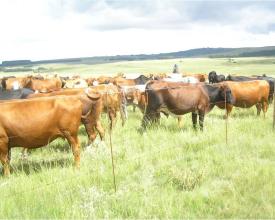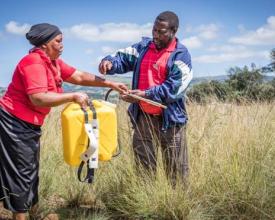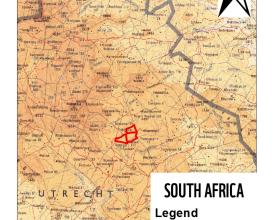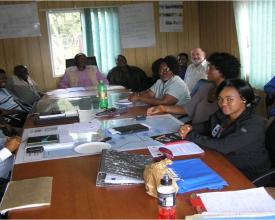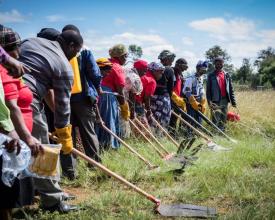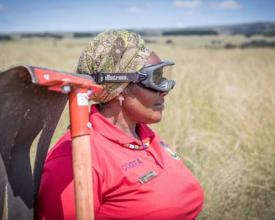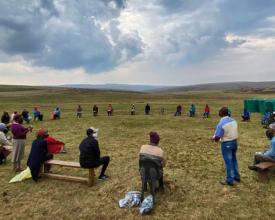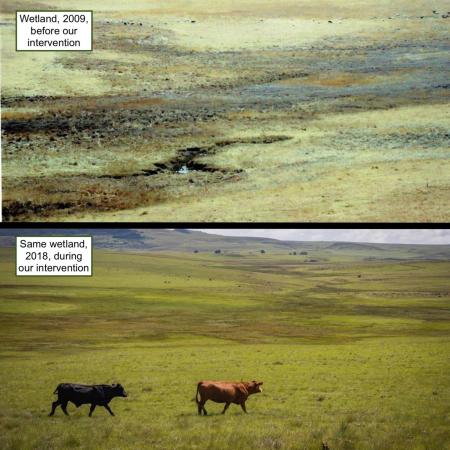
Empowering Custodians of Biodiversity Stewardship
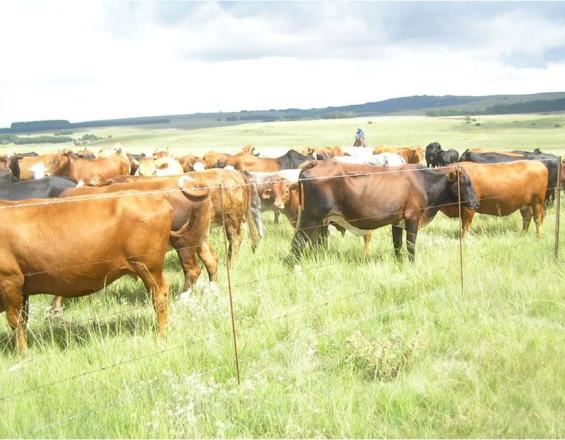
The Mgundeni community got their land back in 1999 and the community is currently under the leadership of iNkosi Z.G. Mabaso. The community formed the Mgundeni Trust. The property comprises one grassland type Wakkerstroom Grassland Montane which provides habitat to some important Vulnerable bird species and qualifies the property to become a Nature Reserve. The community opted for a Biodiversity Agreement as a pilot under the Biodiversity Stewardship Programme. Now that the community is capacitated sufficiently they have upgraded to a Protected Environment (PE) category. The community would like to continue grazing their livestock on the portion for which they have signed for incorporation into the PE but they will follow correct grazing and burning regimes, guided by the veld condition assessments results (3.8 ha/Au for 365 days) that were conducted in 2014.
Context
Challenges addressed
The program is trying to realise a long-term sustainable use of priority (biodiverse and water producing) land through conservation of traditional community-owned / managed areas and the maintenance of a rural economy based on the wise use of natural resources. Under biodiversity stewardship, the land remains the property of the landowner. Biodiversity stewardship is particularly effective in multiple-use landscapes where biodiversity priority areas are embedded in a matrix of other land uses. A flexible range of biodiversity stewardship agreements is available that can combine biodiversity protection and sustainable agricultural production. This makes biodiversity stewardship appropriate for a wide variety of landscapes, including agricultural and communal areas.
Location
Process
Summary of the process
Biodiversity stewardship is an approach to entering into agreements with private and communal landowners to protect and manage land in biodiversity priority areas, led by conservation authorities in South Africa. It recognises landowners as the custodians of biodiversity on their land. Biodiversity stewardship is based on voluntary commitments from landowners, with a range of different types of Biodiversity Stewardship Agreements available to support conservation and sustainable resource use. The provincial biodiversity stewardship programmes aim to provide incentives to participating landowners, in relation to the level of commitment from the landowner. Incentives include technical advice and support on biodiversity management, such as invasive alien control and burning of firebreaks; game donations of founder populations by conservation authorities to the landowners; and recognition and marketing opportunities. By taking care of community needs such as skills development and job creation the protection of natural resources happens automatically and local community members end up seeing the value through the selling of livestock in auctions which talks directly to their financial needs.
Building Blocks
Stewardship skills development
Biodiversity stewardship is an approach to entering into agreements with private and communal landowners to protect and manage land in biodiversity priority areas, led by conservation authorities in South Africa. It recognises landowners as the custodians of biodiversity on their land. Biodiversity stewardship is based on voluntary commitments from landowners, with a range of different types of biodiversity stewardship agreements available to support conservation and sustainable resource use. Some types of biodiversity stewardship agreements are formally declared as protected areas in terms of the Protected Areas Act, providing long-term security for the sites involved.
Enabling factors
Any project that is in the national biodiversity stewardship program must comply with the National Environmental Management Protected Areas Act (NEMPAA) regulations and ensure they take care of biodiversity on their property.
Lesson learned
WWF-SA learnt that training in fire management also helps community members to get job opportunities within big municipalities and also contributes to food security.
Realising ecological, economic and social benefits
Biodiversity stewardship can be important to realising the ecological, economic and social benefits that healthy ecosystems can deliver over the long term. Biodiversity stewardship can stimulate rural economic development by creating a focus for nature-based tourism and sustainable natural resource use. This assists in the diversification of rural livelihoods, especially in agriculturally marginal areas. Biodiversity stewardship sites can also support job creation and skills development through direct land management and restoration, or indirectly through compatible commercial activities. In South Africa, land reform often results in new communal land ownership. In these areas, biodiversity stewardship can help to ensure access to the economic opportunities associated with protected areas.
Enabling factors
Any project that is in the national biodiversity stewardship program but comply with the National Environmental Management Protected Areas Act (NEMPAA) regulations and ensure they take care of biodiversity on their property.
Lesson learned
WWF-SA learnt that training in fire management also helps community members to get job opportunities within big municipalities and also contributes to food security.
Impacts
Biodiversity stewardship has become one of the most important tools for expanding South Africa’s network of protected areas and conservation areas. In recent times, the value of the biodiversity stewardship approach has gone beyond the role of protected area expansion but is increasingly being seen as an approach to meet a range of other environmental outcomes. These include securing ecological infrastructure (strategic water source areas), mitigating the effects of climate change, skills development and supporting the implementation of the South African biodiversity economy programme of work. Biodiversity stewardship has the capacity to support the country’s development agenda in addition to meeting national and international biodiversity goals. The evidence is clear where the biodiversity stewardship program has contributed immensely towards both natural resource management at a lower cost and socio-economic improvement at a household level.
Beneficiaries
Mgundeni community is the main beneficiary of this project.
Sustainable Development Goals
Story

The Mabaso (Mgundeni) Community Protected Environment area will use fire primarily as a grassland management tool to ensure the maintenance of biodiversity value and prevent the damage of the forest margins. The management structures will meet annually before the fire season, when the previous season’s burns will be reviewed, and based on the Fire Management Plan, management compartments will be scheduled for burns in the upcoming fire season and will be recorded as the Annual Burning Plan for implementation. The community was trained through the assistance of WWF-SA in fire-fighting and provided with equipment. The spin-off from the training is that the community members are now being utilized by the Amajuba district municipality in fighting run-away fires for the district and they are getting seasonal part-time jobs. The following species have historically been recorded on the property – Wattled crane Bugeranus carunculatus (CE), Rudd’s Lark Heteromirafra ruddi (E), Yellow-breasted Pipit Anthus chloris (V), Grey Crowned Crane Balearica regulorum (V), the Southern Bald Ibis Geronticus calvus (V) and the Secretarybird Saggittarius serpentarius (NT). The area is very rich in cultural heritage as evidenced by a stone-built livestock wall built during the time of King Dingaan, a tree called “iLembe Tree” (used for community discussions during the time of King Shaka), a traditional sharpening stone for spears called an “uMkhonto sharpening stone” and an “Impi” (Warriors) house, just to name a few of the local features. The socio-economic study was conducted in the area and it showed that a viable business would be for the community to lease their land to a livestock farmer. However, the community chose to start their own sustainable livestock farming business. In 2015 iNkosi Mabaso confirmed that the grazing plans system does improve grasslands on their farm and the whole community agreed to allow the herd of cows to grow from 520 to about 650. This community has accessed a white commercial market where they are selling their livestock in three different auctions and people are utilizing those funds in taking care of their families and some are taking their kids to school which is very far from this isolated community; this talks to socio-economic improvement at a household level. The photo below shows that the change in governance over a long time and dedication to success from a group of people does produce livestock of good quality while taking care of the veld.
